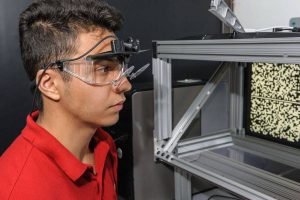Convergence insufficiency (CI) affects up to 15 percent of all school-age children.
Convergence insufficiency is a binocular vision condition that affects near vision and eye muscle coordination.
This condition occurs when the eyes are unable to effectively work together to focus on a near object. As a result, additional effort is needed for focusing on reading and other near vision tasks.
Convergence insufficiency can affect a child’s reading and learning success, and even impact concentration and sports performance.
Since school vision screenings only test distance vision acuity, they cannot detect the presence of CI— leading to many undiagnosed children.
As a result, many children with CI are often mislabeled as lazy or spacey, and even misdiagnosed with ADHD, dyslexia, or Asperger’s syndrome.
Students who have received treatment for this condition often notice dramatic improvements in their reading, learning and overall school performances.
How is CI treated?
The Convergence Insufficiency Treatment Trial study conducted by the National Eye Institute (NEI) revealed that supervised vision therapy with home reinforcement is the most effective treatment for CI.
According to the NEI research, 75 percent of the study’s participants obtained either full vision correction or noticed a significant vision improvement within 12 weeks of in-office vision therapy.
Signs that your child may have CI
Children with CI may exhibit any of the following:
- Reading below grade level
- Homework avoidance
- Attention and concentration difficulties
- Blurred vision
- Double vision
- Headaches
- Fatigue, especially when reading
- Seeing words move or jump on the page
- Motion sickness or vertigo
If your child has any of these signs above, contact an eye doctor near you, who can diagnose and treat the underlying vision problems.
SEE RELATED: Do I Have Convergence Insufficiency?
What is vision therapy?
Vision therapy focuses on training the eyes to work together— improving 3-D vision, depth perception, and binocular vision.
A vision therapy program may include specialized lenses, prisms, eye exercises, and computerized technology to stimulate and strengthen the connections between the eyes and brain, to improve eye focusing and coordination abilities.
The goal of vision therapy is to strengthen the communication between the eyes and brain for clear and comfortable vision for all visually demanding activities.
Although vision therapy is most effective in childhood when the brain is still developing, adults with CI can benefit from vision therapy as well— though the results may take a bit longer to achieve.
A developmental optometrist will assess your child’s functional vision to determine if CI is at the root of their headaches, reduced concentration, and reading and learning difficulties.
LEARN MORE: Vision Therapy for Children
If you or your child is showing signs of CI or a reading or learning disability, schedule an eye exam with a developmental optometrist.
If CI is detected, a program of vision therapy may be recommended to improve your child’s visual skills and enhance their academic performance.








